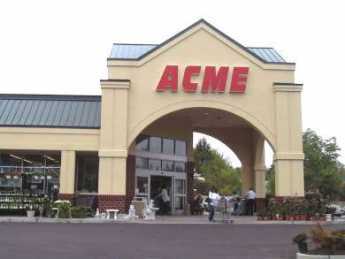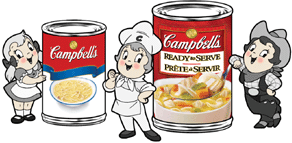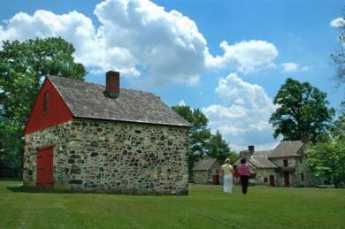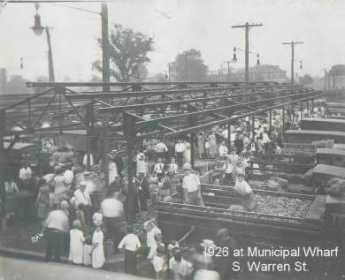Related Topics
Philadelphia Fish and Fishing
Less than a century ago, Delaware Bay, Delaware River, Schuylkill River, Pennypack Creek, Wissahickon Creek, and dozens of other creeks in this swampy region were teeming with edible fish, oysters and crabs. They may be coming back, cautiously.
City of Rivers and Rivulets
Philadelphia has always been defined by the waters that surround it.
Customs, Culture and Traditions
Abundant seafood made it easy to settle here. Agriculture takes longer.
Philadelphia Food: Ingredients

|
| Super Market |
There was a time when locally grown farm produce was much more critical than it is at present. There were even resort hotels with their own farms that offered fresh vegetables as the main attraction for vacationers, but now almost any supermarket will supply reasonably good produce to most places in the country. Nevertheless, certain things like fresh corn on the cob must be cooked and eaten almost the same day they are picked, and such seasonal local produce is better around Philadelphia than any other metropolitan area.

|
| Campbell Soup Kids |
The states of Delaware and New Jersey were once Atlantic barrier islands, so the sandy loam is particularly favorable for growing asparagus, for example. An asparagus field is planted as perennials, with new shoots harvested by stoop labor fields of asparagus is difficult to plant and quite valuable once established. Tomatoes are annuals, which in their finest form will continuously produce all summer. It's only worth planting "steak" tomatoes, or so-called Jersey Tomatoes, if there is a local market willing to pay premium prices for the fact that the human picker can tell a green one from a red one. The tomato industry which once supplied Campbell Soup to the world has now mostly moved to California where improved varieties of soup-grade tomatoes all ripen simultaneously, thus can be harvested with machinery at a single pass. Lancaster County in Pennsylvania boasts the best topsoil in the country, although it must be admitted that the glaciers dumped topsoil fourteen feet deep around northern Illinois. Such topsoil is almost too valuable to be used for truck gardens. Lancaster County grows fodder for cattle, and the cattle are hidden away in barns where passersby never see them, just as you never see chickens when you drive through Delaware. What visitors see are silos in Lancaster County and chicken sheds in the lower counties, and acres and acres of animal-feed crops (field corn and soybeans) surrounding the farms. A century ago, all those Swamps("wetland") around Delaware Bay held lots of ducks, geese, quail, and other game, but the game is less popular than it used to be. Location, location is always the true source of value, and in this case, the source of good Philadelphia food is the local location of a vast variety of fresh produce.

|
| Brandywine Battlefield |
Somewhere, the story needs to be retold of the mushroom growers of Kennett Square. This little nondescript town near the Brandywine Battlefield at the top of the state of Delaware was the mushroom capital of the world. It stayed that way for generations, by keeping the secrets of the mushroom trade a strict family secret. Among the various oddities was the production around Thanksgiving time of the first crop of the season, which were often as large as grapefruit, and usually only given to members of the family or special friends actually to be carved at the Thanksgiving table next to the turkey. During the Second World War, Franklin Roosevelt (his daughter-in-law was Ethel DuPont, who lived nearby) personally appealed to the mushroom farmers to reveal their secret methods to the makers of penicillin, needed for the war effort. The farmers gave it up, penicillin saved thousands of lives. And nowadays, most mushrooms in American supermarkets are grown in Taiwan, flown in at prices the Kennet Square growers cannot match.
Real estate developers are doing their best to fill up those truck gardens with split-level houses, of course, and the lovers of good food are allies of the lovers of the environment. So, the individual householder needs to know how to find the Red, Blue and Green Dot roadside farm stands along the highway to the Jersey shore, when the Jersey corn, tomatoes, and melons are at their best, or earlier in the year when Jersey berries are available. You need to know about the Reading Terminal Marketplace, the South Philadelphia street markets, the ethnic neighborhood butcher shops and bakeries, the Kutztown Fair and the farmer's markets in Lancaster County. It's surprising what you can order over the internet, but for the really choice fresh produce in season, you have to hunt around a little.
The farmers of South Jersey have traditionally been Quakers. One Quaker family named Taylor has had a farm right next to the Delaware River in Cinnaminson, just north of the Tacony Palmyra Bridge, since the days of William Penn. Taylors signed the 1783 minute of the Yearly Meeting of Quakers to the Continental Congress, advocating an end to slavery. As the Cinnaminson area became built up, the Taylors had a thriving fruit and vegetable stand, which was left unattended. That is, Joe Taylor brought out the corn and other produce and left it on the stand, while the customers just came up and left their money in a box on the same table. No one stole the money for a century, just as no one in the neighborhood ever locked the door of his house. As things evolved, Joe Taylor, Jr. eventually won the 1993 Nobel Prize in Physics for discoveries helping to explain the force of gravity. But in time, the family decided to give up the farm and turned it over to the State as a nature preserve. Undoubtedly a major factor in the decision, if not the only deciding factor, was the repeated discovery that people were stealing the money from the vegetable stand box.

|
| Market on Spruce Street |
For the most part, however, the supermarkets and the chefs of Philadelphia's restaurant revolution nowadays just need to go to the South Philadelphia Food Distribution Center, down in the old filled-in swamp and garbage dump area at the foot of the Walt Whitman Bridge. This is Harry Batten's gift to his city. The former chief of the N.W. Ayer advertising agency made it a personal crusade to put across a remarkable transformation in his home town. Until well past the Korean War, wholesale food distribution took place in the streets of the former Society Hill, never mind how historic it is. Traffic was at a crawl, cartons of vegetables were strewn over the streets, the noise and stench of America's Most Historic Square Mile was a disgrace. The city was persuaded to set aside land for the purpose, and the wholesale grocers were persuaded to move their warehouses to one combined location with rail, bridge, highway and local access. Within months of opening, the wholesale grocery business had moved to the new location, where it became an international marvel. Meanwhile, Charles E. Peterson bought a Spruce Street mansion that once belonged to Stephen Girard from the old Spruce Street Osteopathic Hospital for $8,000.00, rehabilitated it in absolutely authentic style, and moved into the new home, himself. Society Hill Restoration had begun, Philadelphia's restaurant revolution had begun, a great many people became millionaires out of the commercial side of the process, tax ratables soared, tourists poured into the Independence Park area and Penn's Landing and the Camden waterfront. It's been a long time since Harry Batten's name was heard much, but he ought to have a bronze statue sixty feet high. As the Quakers say, you can do anything if you have leadership. And leadership is one man.
Originally published: Thursday, July 04, 1996; most-recently modified: Friday, May 31, 2019